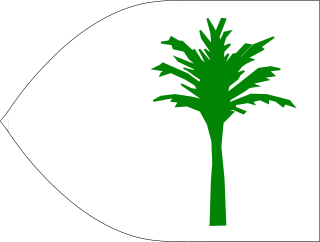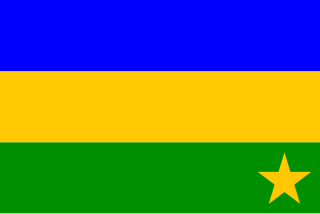Related Research Articles
Chad, officially the Republic of Chad, is a landlocked country in Central Africa. It borders Libya to the north, Sudan to the east, the Central African Republic to the south, Cameroon and Nigeria to the southwest, and Niger to the west. Due to its distance from the sea and its largely desert climate, the country is sometimes referred to as the "Dead Heart of Africa".

The Kanem–Bornu Empire existed in areas which are now part of Nigeria, Niger, Cameroon, Libya and Chad. It was known to the Arabian geographers as the Kanem Empire from the 8th century AD onward and lasted as the independent kingdom of Bornu until 1900.

The Kanuri people are an African ethnic group living largely in the lands of the former Kanem and Bornu Empires in Niger, Nigeria, Chad, and Cameroon, as well as a diaspora community residing in Sudan. Those generally termed Kanuri include several subgroups and dialect groups, some of whom identify as distinct from the Kanuri. Most trace their origins to ruling lineages of the medieval Kanem–Bornu Empire, and its client states or provinces. In contrast to the neighboring Toubou or Zaghawa pastoralists, Kanuri groups have traditionally been sedentary, engaging in farming, fishing the Chad Basin, trade, and salt processing.
Ngazargamu, Birni Ngazargamu, Birnin Gazargamu, Gazargamo or N'gazargamu, was the capital of the Bornu Empire from ca. 1460 to 1809. Situated 150 km (93 mi) west of Lake Chad in the Yobe State of modern Nigeria, the remains of the former capital city are still visible. The surrounding wall is 6.6 km (4.1 mi) long and in parts it is still up to 5 m (16 ft) high.
The Karamanli dynasty was an autonomous dynasty that ruled Ottoman Tripolitania from 1711 to 1835. Their territory comprised Tripoli and its surroundings in present-day Libya. At its peak, the Karamanli dynasty's influence reached Cyrenaica and Fezzan, covering most of Libya. The founder of the dynasty was Ahmed Karamanli, a descendant of the medieval Karamanids. The most well-known Karamanli ruler was Yusuf ibn Ali Karamanli who reigned from 1795 to 1832, who fought a war with the United States between 1801 and 1805. Ali II was the last of the dynasty.

Sayfawa dynasty, Sefouwa, Sefawa, or Sefuwa dynasty is the name of the Muslim kings of the Kanem–Bornu Empire, centered first in Kanem in western Chad, and then, after 1380, in Borno.
Dunama Dabbalemi, or Dounama Dibbalém, of the Sayfawa dynasty, was the mai (king) of the Kanem Empire, in present-day Chad, from 1210 to 1224.

The Bilala or Bulala are a Muslim people that live around Lake Fitri, in the Batha Prefecture, in central Chad. The last Chadian census in 1993 stated that they numbered 136,629 people. Their language, Naba, is divided in four dialects and is a part of the Central Sudanic language family; it is shared by two of their neighbours, the Kuka and the Medogo. These three peoples are collectively known as Lisi and are believed to be descendants of main ethnic groups of the Sultanate of Yao.
al-Haj Idris Alooma was Mai (ruler) of the Bornu empire, covering parts of Chad, Cameroon, Niger and Nigeria. His achievements are primarily chronicled by Ahmad bin Fartuwa, his chief Imam. His reign marked the end of the Kanem civil wars within the state, reuniting N'jimi, the former capital, under Sayfawa control. Furthermore, he introduced significant legal reforms based on Islamic law, establishing qadi courts that operated independently from the executive branch. He is credited with leading the empire to what is often regarded as its zenith during the late 16th-century and early 17th-century.
Ahmad bin Furtu or Ibn Furtu was the sixteenth century grand Imam of the Bornu Empire and the chronicler of Mai Idris Alooma (1564–1596).
Muhammed Dunama bin Hummay I (1092-1150) was the king of the Kanem–Bornu Empire and a member of the Sayfawa dynasty. He was born to Hummay and a Toubou wife and succeeded his father as king in 1097 when Hummay died in Egypt on the hajj. Dunama made the pilgrimage twice in his own right, each time leaving 300 slaves in Egypt as gifts for his hosts. He was succeeded by his son, Bir I of Kanem.
Omar Ibn Idris, or Umar Idrismi, Idris Dunama III, was the ruler of the Kanem Empire from 1372 to 1380. He moved the capital from Njimi, Kanem to Kaga, located on the western edge of Lake Chad in present day Borno State, Nigeria.

This is a timeline of Nigerian history, comprising important legal and territorial changes and political events in Nigeria and its predecessor states. To read about the background to these events, see History of Nigeria. See also the list of heads of state of Nigeria.
The Ngizim people live in Yobe State, northeastern Nigeria. As of 1993, there were an estimated 80,000 Ngizim. The tribe lives primarily in Potiskum, the largest city in Yobe State and originally a Ngizim town, as well as the areas to the east and south of the city. Ngizim populations once inhabited parts of Borno and Jigawa states, but have since lost their cultural identity after being assimilated into other ethnic groups. The Ngizim speak a Chadic language also called Ngizim.

Shehu Muhammad al-Amîn al-Kanemi was an Islamic scholar, teacher, religious and political leader who advised and eventually supplanted the Sayfawa dynasty of the Kanem–Bornu Empire. In 1846, al-Kanemi's son Umar I ibn Muhammad al-Amin became the sole ruler of Borno, an event which marked the end of the Sayfawa dynasty's 800 year rule. The current Shehu of Bornu, a traditional ruler whose seat remains in modern Borno State, Nigeria, is descended from al-Kanemi.
Zawila is a village in southwestern Libya. During the Middle Ages, it was the capital of the Fezzan region.

The history of Northern Nigeria covers the history of the region form pre-historic times to the modern period of Northern Nigerian state.
Aissa Koli also called Aisa Kili Ngirmaramma was a queen regnant in the Kanem–Bornu Empire in 1497–1504 or 1563–1570. She was a Magira who ruled in her own right.
Muhammad Dan Abdullahi, known as Muhammad Kisoki, was the Sultan of Kano from 1509 until his death in 1565. His 56-year reign is the longest of the state's Rumfawa era.

The history of Central Africa has been divided into its prehistory, its ancient history, the major polities flourishing, the colonial period, and the post-colonial period, in which the current nations were formed. Central Africa is the central region of Africa, bordered by North Africa, West Africa, East Africa, Southern Africa, the Atlantic Ocean, and the Sahara Desert. Colonial boundaries are reflected in the modern boundaries between contemporary Central African states, cutting across ethnic and cultural lines, often dividing single ethnic groups between two or more states.
References
- ↑ Urvoy, Y. (1949). Historie De L'Empire Du Bronu (Memoires De L'Institut Francais D'Afrique Noire, No. 7 ed.). Paris: Librairie Larose. p. 56.
- ↑ Palmer, Richmond (1936). The Bornu Sahara and Sudan. London: John Murray. pp. 94, 222–225.
- ↑ Barth, Henry (1890). Travels and Discoveries in North and Central Africa. London: Ward, Lock, and Co. p. 361 . Retrieved 10 March 2019.
- 1 2 3 4 5 6 Ajayi, J. F. Ade (1976). History of West Africa. Internet Archive. New York : Columbia University Press. pp. 175–176. ISBN 978-0-231-04103-4.
- 1 2 3 4 5 J.F. and Ian Espie Ajayi (1969). One Thousand Years of West African History. Internet Archive. Prometheus Books. p. 77. ISBN 978-0-391-00217-3.
- 1 2 3 4 History Of The First Twelve Years Of The Reign Of Mai Idris Alooma Of Bornu ( 1571 1583) ( Fartua, Ahmed Ibn). 1926. p. 14.
- ↑ Waziri, Muhammad (2000). Meanings of Kanuri Personal Names. Maiduguri: Gargam Publishers (Nig) Limited. p. 21. ISBN 9781257334.